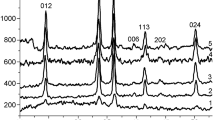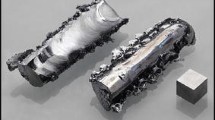Conclusions
-
1.
Reduction treatments of chromium oxide systems with different reducing agents produced surface atoms of Cr(II), whose number was determined by: the total number of chromium atoms on the surface, the chemical composition of the surface compounds being reduced, the reducing conditions (i.e., the optimum reduction temperature of H2 was 550°C at a gas feed rate of over 400 h−1). The maximum concentration of Cr(II) was independent of the nature of the reducing agent (H2, CO, CH4, C5H12).
-
2.
The stability of Cr(II) atoms in reduced chromium oxide systems was significantly higher than was expected from thermodynamic calculations.
Similar content being viewed by others
Literature cited
V. P. Gel'd and O. A. Esin, High-Temperature Reduction Processes, [in Russian], Metallurgizdat, Sverdlovsk (1957), p. 5.
H. L. Krause and H. L. Stach, Z. Anorg. Allg. Chem.,366, 34 (1969).
L. K. Prezheval'skaya, V. A. Shvets, and V. B. Kazanskii, Kinet. Katal.20, 1005 (1979).
A. Zecchina, G. Garrone, G. Ghiotti, et al., J. Phys. Chem.,79, 966 (1975).
F. Moeseler, B. Horvath, D. Lindenav, et al., Z. Naturforsch.,31, 892 (1976).
S. W. Weller and S. E. Volts, J. Am. Chem. Soc.,76, 4695 (1954).
L. L. Van Reijen, W. M. Sachtler, F. Cossee, and D. M. Brouwer, Proc. III Congr. of Catalysis, Amsterdam, Vol. 2 (1965), p. 829.
T. S. Vinnikova, K. I. Slovetskaya, and A. M. Rubinshtein, Kinet. Katal.,13, 1282 (1972).
K. I. Slovetskaya, É. G. Aleshin, and A. M. Rubinshtein, Zavod. Lab., No. 2, 12 (1985).
V. Gryunert, E. S. Shpiro, G. V. Antoshin, et al., Dokl. Akad. Nauk SSSR,284, 372 (1985).
K. I. Slovetskaya, A. M. Rubinshtein, E. A. Timofeeva, et al., Izv. Akad. Nauk SSSR, Ser. Khim., 1467 (1975).
M. M. Daniel, J. Catal.,67, 71 (1981); 76, 37 (1982).
G. P. Poole and D. S. MacIver, Advanced Catalysis and Related Subjects, Vol.17, Academic Press, New York (1967), p. 224.
K. I. Slovetskaya, G. V. Milorova, A. M. Rubinshtein, et al., Izv. Akad. Nauk SSSR, Ser. Khim., 253 (1981).
Author information
Authors and Affiliations
Additional information
Translated from Izvestiya Akademii Nauk SSSR, Seriya Khimicheskaya, No. 7, pp. 1501–1505, July, 1988.
Rights and permissions
About this article
Cite this article
Slovetskaya, K.I., Aleshin, É.G. & Rubinshtein, A.M. Divalent chromium in reduced chromium oxide systems; determination of its amount and investigation of its properties. Russ Chem Bull 37, 1324–1328 (1988). https://doi.org/10.1007/BF00962731
Received:
Issue Date:
DOI: https://doi.org/10.1007/BF00962731




